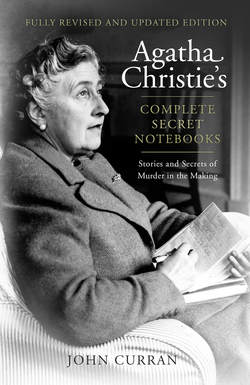Читать книгу Agatha Christie’s Complete Secret Notebooks - Агата Кристи, Agatha Christie, Detection Club The - Страница 33
Dumb Witnesses
ОглавлениеIn February 1955, on the BBC radio programme Close-Up, Agatha Christie admitted, when asked about her process of working, that ‘the disappointing truth is that I haven’t much method’. She typed her own drafts ‘on an ancient faithful typewriter that I’ve had for years’ but she found a Dictaphone useful for short stories. ‘The real work is done in thinking out the development of your story and worrying about it until it comes right. That may take quite a while.’ And this is where her Notebooks, which are not mentioned in the interview, came in. A glance at them shows that this is where she did her ‘thinking and worrying’.
Up to the early-1930s her Notebooks are succinct outlines of the novels with relatively little evidence of rough notes or speculation, deletions or crossing-out. And, unlike later years, when each Notebook contains notes for a few titles, at that early stage the bulk of the notes for any title is contained within one Notebook. These outlines follow closely the finished novel and would seem to indicate that the ‘thinking and worrying’ was done elsewhere and subsequently destroyed or lost. Notes for The Mysterious Affair at Styles (Notebook 37), The Man in the Brown Suit (Notebook 34), The Mystery of the Blue Train (Notebook 54), The Murder at the Vicarage (Notebook 33), The Sittaford Mystery (Notebook 59), Peril at End House (Notebook 68) and Lord Edgware Dies (Notebook 41) are accurate reflections of the novels. But from the mid-1930s and Death in the Clouds on, the Notebooks include all her thoughts and ideas, accepted or rejected.
She did all her speculating on the page of the Notebook until she was happy with the plot, although it is not always obvious from the Notebook alone which plan she has adopted. She worked out variations and possibilities; she selected and discarded; she explored and experimented. She ‘brainstormed’ on the page, and then sorted the potentially useful from the probably useless. Notes for different books overlap and intersect; a single title skips throughout a Notebook or, in extreme cases, through a dozen Notebooks.
When asked by Lord Snowdon in a 1974 interview how she would like to be remembered, Agatha Christie replied, ‘I would like to be remembered as a rather good writer of detective stories.’ This modest remark, coming after a lifetime as a bestseller in bookshop and theatre, is unconscious confirmation of another aspect of Christie evident from the Notebooks, her lack of self-importance. She saw these unpretentious jotters as no more precious a tool in her working life than the pen or pencil or biro she held to fill them. She employed her Notebooks as diaries, as scribblers, as telephone-message pads, as travel logs, as household accounts ledgers; she used them to draft letters, to list Christmas and birthday presents, to scribble to-do reminders, to record books read and books to read, to scrawl travel directions. She sketched maps of Warmsley Heath (Taken at the Flood) and St Mary Mead in them; she doodled the jacket design for Sad Cypress and the stage setting for Afternoon at the Seaside in them; she drew diagrams of the plane compartment from Death in the Clouds and the island from Evil under the Sun in them. Sir Max used them to do calculations, Rosalind used them to practise her handwriting and everyone used them as bridge-score keepers.
